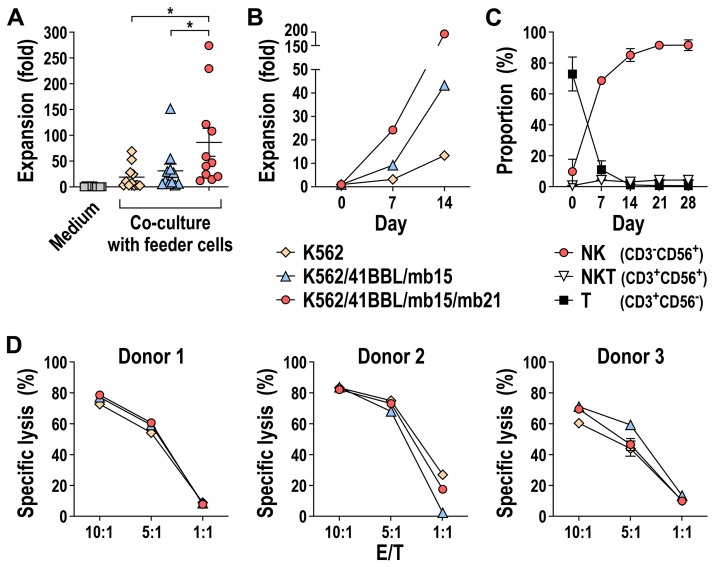Figure 5.
Selective expansion of CD56+ NK cells from peripheral blood with K562/41BBL/mb15/mb21 feeder cells. Peripheral blood mononuclear cells (PBMCs) from healthy donors were mixed with lethally irradiated K562/41BBL/mb15/mb21 or K562/41BBL/mb15 cells at a ratio of 1.5:1 (PBMCs/feeder cells) and cultured in medium containing 50 IU/mL of IL-2. For comparison, NK cells from peripheral blood were expanded using either irradiated parental K562 cells or only IL-2-containing culture medium. (A) Expansion of CD56+CD3- NK cells after seven days of co-culture with different feeder cells relative to the number of input cells (day 0) was analyzed by flow cytometry using specific fluorochrome-conjugated antibodies. Note: n = 11 individual donors. Individual data points and mean values ± SEM are shown; * p < 0.05. (B) On day 7, expanded NK cells were restimulated with the respective feeder cells, and expansion of NK cells on day 14 was determined as described in (A). Data for a representative donor are shown. (C) Immune cell composition (NK, NKT, and T cells) in K562/41BBL/mb15/mb21 feeder cell-stimulated cell pools was determined over time by flow cytometry using CD56- and CD3-specific antibodies. Mean values ± SEM are shown; n = 2 individual donors. (D) Cytotoxicity of CD56+ NK cells expanded from PBMCs of three individual donors using the feeder cells indicated in (A) and (B) against K562 cells was determined in flow-cytometry-based cytotoxicity assays at different effector to target (E/T) ratios, as indicated. E/T ratios were calculated based on the proportion of CD56+ NK cells. Mean values ± SEM of three technical replicates for each donor are shown.

